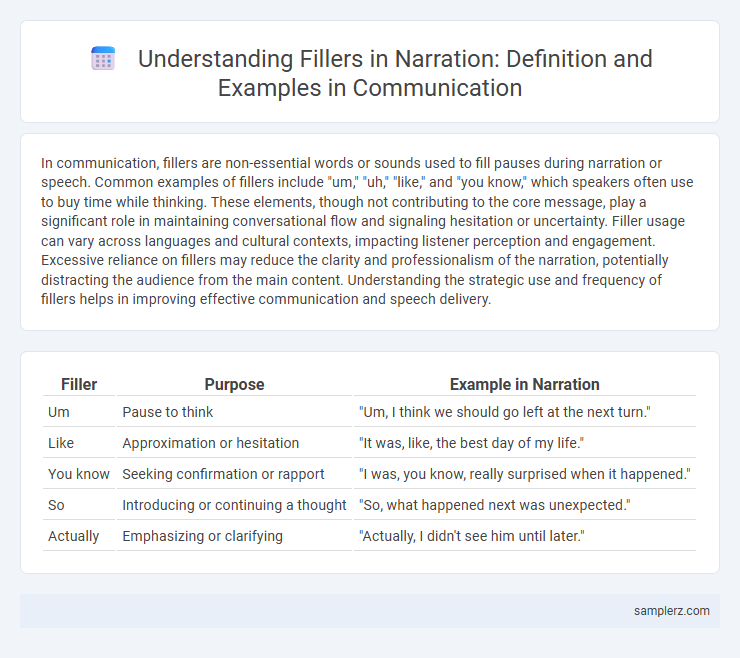In communication, fillers are non-essential words or sounds used to fill pauses during narration or speech. Common examples of fillers include "um," "uh," "like," and "you know," which speakers often use to buy time while thinking. These elements, though not contributing to the core message, play a significant role in maintaining conversational flow and signaling hesitation or uncertainty. Filler usage can vary across languages and cultural contexts, impacting listener perception and engagement. Excessive reliance on fillers may reduce the clarity and professionalism of the narration, potentially distracting the audience from the main content. Understanding the strategic use and frequency of fillers helps in improving effective communication and speech delivery.
Table of Comparison
| Filler | Purpose | Example in Narration |
|---|---|---|
| Um | Pause to think | "Um, I think we should go left at the next turn." |
| Like | Approximation or hesitation | "It was, like, the best day of my life." |
| You know | Seeking confirmation or rapport | "I was, you know, really surprised when it happened." |
| So | Introducing or continuing a thought | "So, what happened next was unexpected." |
| Actually | Emphasizing or clarifying | "Actually, I didn't see him until later." |
Understanding Fillers in Narration
Fillers such as "um," "uh," and "you know" are common in narration, serving as brief pauses that allow speakers to organize thoughts without losing the listener's attention. Recognizing these fillers enhances understanding by revealing the speaker's cognitive processing and hesitation patterns. Effective communication involves minimizing fillers to maintain clarity and audience engagement.
Common Types of Fillers Used in Storytelling
Common types of fillers used in storytelling include "um," "uh," and "like," which speakers often use to manage pauses or gather their thoughts. Phrases such as "you know," "I mean," and "sort of" function as verbal placeholders that maintain listener engagement while the narrator organizes the next part of the story. These fillers can also add a conversational tone, making the narrative feel more relatable and natural.
Linguistic Functions of Fillers
Fillers such as "um," "uh," and "you know" serve crucial linguistic functions in narration by signaling hesitation, managing the flow of speech, and providing the speaker with time to organize thoughts. These vocalized pauses enhance listener comprehension by marking boundaries in discourse and indicating the speaker's intention to continue. Additionally, fillers can convey subtle social cues, such as uncertainty or a desire for reassurance, thereby facilitating smoother interpersonal communication.
Impact of Fillers on Narrative Flow
Fillers such as "um," "like," and "you know" disrupt narrative flow by creating unnecessary pauses that dilute the message's clarity and weaken listener engagement. Frequent use of fillers can signal hesitation or uncertainty, reducing the speaker's perceived credibility and authority. Eliminating or minimizing fillers enhances fluidity, ensuring the narrative maintains momentum and sustains audience attention effectively.
Examples of Filler Words in Spoken Narration
Filler words commonly used in spoken narration include "um," "uh," "like," "you know," and "so," which help speakers manage pauses and think without losing the listener's attention. These fillers often appear in storytelling or presentations to maintain a natural flow and signal hesitation or the need for more processing time. Effective communication encourages minimizing fillers to enhance clarity and professionalism in narration.
Filler Phrases in Written Narratives
Filler phrases in written narratives, such as "you know," "like," and "I mean," serve to mimic natural speech patterns and provide rhythm to storytelling. These phrases can create a conversational tone, making the text more relatable and engaging for readers. Strategic use of fillers enhances the authenticity of character voices while maintaining narrative flow.
Cultural Variations of Fillers in Narration
Fillers such as "um," "like," and "you know" vary significantly across cultures, with Japanese speakers often using "ano" and Spanish speakers preferring "este" to maintain conversational flow. These culturally specific fillers serve not only as placeholders during pauses but also signal politeness, hesitation, or emphasis according to social norms. Understanding these variations enhances cross-cultural communication and improves narrative clarity in multilingual contexts.
How Fillers Shape Character Voices
Fillers such as "um," "like," and "you know" infuse narration with authenticity, revealing characters' hesitation, thought patterns, and emotional states. These vocal pauses craft distinct speech rhythms and unique conversational styles, enhancing character development and relatability. By embedding fillers strategically, writers convey subtle psychological cues that deepen audience engagement.
The Psychological Role of Fillers in Narration
Fillers such as "um," "uh," and "like" serve a crucial psychological role in narration by signaling hesitation, providing the speaker with extra processing time to organize thoughts, and maintaining listener engagement. These verbal pauses act as cognitive placeholders that help manage the speaker's mental workload while preserving the flow of communication. Research in psycholinguistics shows that strategic use of fillers can enhance narrative coherence by allowing speakers to plan complex information delivery without disrupting audience comprehension.
Strategies to Minimize Unnecessary Fillers
Effective strategies to minimize unnecessary fillers in narration include practicing controlled breathing techniques to maintain a steady pace and improve speech clarity. Utilizing pause strategies, such as deliberate silent pauses, enhances listener comprehension by replacing automatic fillers like "um" or "uh." Recording and reviewing narration sessions provide critical feedback, allowing speakers to identify filler patterns and implement targeted improvements for more polished communication.

example of filler in narration Infographic
 samplerz.com
samplerz.com